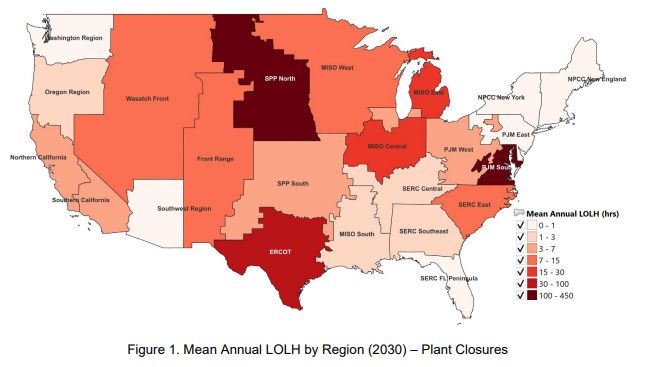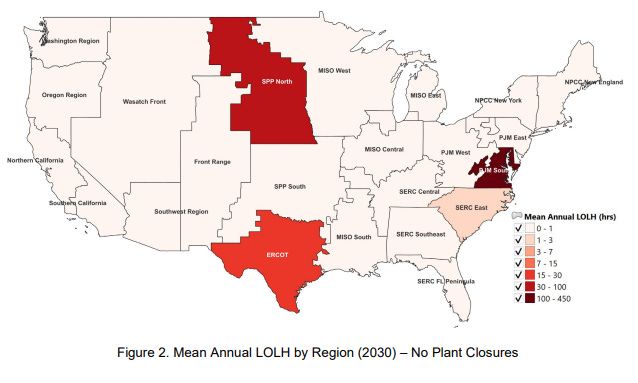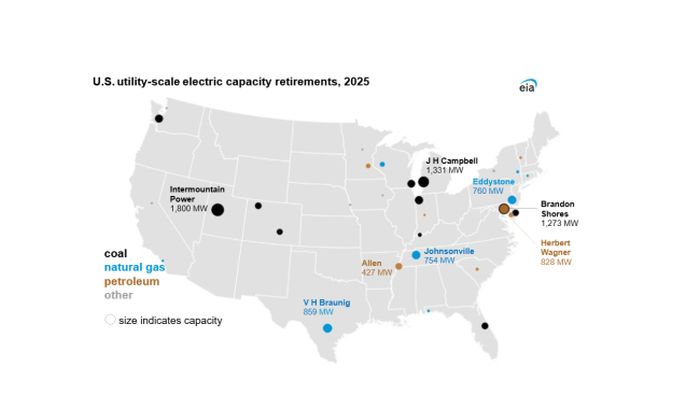Key Takeaways
- The Report favors dispatchable resources over intermittent ones to address resource adequacy concerns and advises against retiring fossil-fuel generating resources.
- The Report introduces a methodology that it claims better measures outage duration and magnitude, using loss of load hours (LOLH) and normalized unserved energy (NUSE) as key metrics.
- The Report identifies SPP North, ERCOT, MISO East and Central, and PJM South as high-risk regions for resource adequacy by 2030; however, its conservative assumptions may overstate reliability concerns by undercounting new resource additions and contributions from new renewable and storage resources that could come online after 2026.
The U.S. Department of Energy (DOE) recently released its resource adequacy report (the Report), which identified several grid regions facing acute reliability issues in the near future that the Report attributes to planned retirements of fossil-fuel generation units.1 The DOE published the Report under President Donald Trump's April 8, 2025, Executive Order (EO) 14262, "Strengthening the Reliability and Security of the United States Electric Grid," which directed the DOE to develop a uniform methodology for analyzing current and anticipated reserve margins across regions of the U.S. bulk power system.2
Summary, Methodology, and Recommendations
The Report claims that a focus on intermittent, renewable sources of energy risks resource adequacy concerns,3 and—under the methodology the Report advances—it maps LOLH, a measure of the expected duration of power outages, and NUSE, a measure of the percentage of total energy demand not met due to insufficient generation or transmission, across grid regions under scenarios with and without the slated retirement of certain fossil-fuel generating units.4
The Report projects that certain grid regions will fail to meet projected demand, which the Report notes is increasing due to manufacturing, re-industrialization, and data center builds to support AI advancement.5 It notes that 104 gigawatts (GW) of firm capacity are slated for retirement by 2030, while only 22 GW of the total 209 GW of new generation to be added by 2030 is firm baseload generation.6
The Report calls for modernizing resource adequacy evaluation methods and accelerating the addition of firm, dispatchable generation. The Report recommends that reforms are needed to address resource adequacy concerns and advances a reliability standard of no more than 2.4 hours of lost load per year and a NUSE below 0.002%.7
Regional Analysis and Areas of Acute Reliability Concern
The Report lays out the regions in which it identified the greatest reliability concern. As seen in the maps below, the Report identified Southwest Power Pool (SPP) North, North, Electric Reliability Council of Texas (ERCOT), Midcontinent Independent System Operator (MISO) East and Central, and PJM South as having the highest projected mean annual LOLH, and it projected SPP North, ERCOT, MISO, PJM South, and SERC East to have the highest mean annual NUSE by 2030 if all slated generation retirements and additions go through.8
The maps below show a comparison of the Report's model results showing mean annual LOLH across a "plant closures" scenario, assuming all 104 GW of announced retirements based on North American Reliability Corporation (NERC) estimates, including 71 GW of coal and 25 GW of natural gas and 100% of NERC's Long-Term Reliability Assessment Tier 1 additions totaling 209 GW, made up primarily of renewables, and a "no plant closures" scenario, adding all the Tier 1 NERC additions but assuming no retirements on the other hand.9

[Source: Report, p. 6]

[Source: Report, p. 6]
There is meaningful overlap between the regions that the Report identifies as at highest risk and regions where significant planned coal, natural gas, and petroleum generating unit retirements are scheduled as of 2025:

[Source U.S. Energy Information Administration, Planned retirements of U.S. coal-fired electric-generating capacity to increase in 2025 (Feb. 25, 2025), https://www.eia.gov/todayinenergy/detail.php?id=64604]
More than a month before the DOE published the Report, the secretary of energy halted the closure of natural gas generating units in PJM and a coal-fired power plant in MISO under his authority under the Federal Power Act and pursuant to President Trump's April 8, 2025, EO, "Strengthening the Reliability and Security of the United States Electric Grid." The Report may provide insight into where the secretary may focus such efforts going forward, but how far the secretary may stretch his authority under Federal Power Act Section 202(c) to issue emergency orders that keep preferred baseload resources—like coal, natural gas, and nuclear—operating remains to be seen.
Footnotes
1. U.S. Department of Energy, Evaluating the Reliability and Security of the United States Electric Grid (July 2025), https://www.energy.gov/sites/default/files/2025-07/DOE%20Final%20EO%20Report%20%28FINAL%20JULY%207%29.pdf.
2. Id. at vi.
3. Id. at 1.
4. Id. at 2–3.
5. Id. at 1.
6. Id.
7. Id. at 1, 4.
8. Id. at 5–6.
9. Id. at 5.
The content of this article is intended to provide a general guide to the subject matter. Specialist advice should be sought about your specific circumstances.




